Contents
Today, no one can surprise anyone with a vineyard in their garden. But it is worth remembering that grapes are a rather demanding plant. In order to get a big harvest, while maintaining the health of the plant, you need to spend a lot of effort. A novice gardener can even ruin grapes if he acts at random. One of the mandatory care processes is pruning. This article is devoted to exactly how to trim grapes for beginners.
Optimal cutting time
First of all, a beginner should know the time when pruning can be done. It may vary depending on the grape variety.
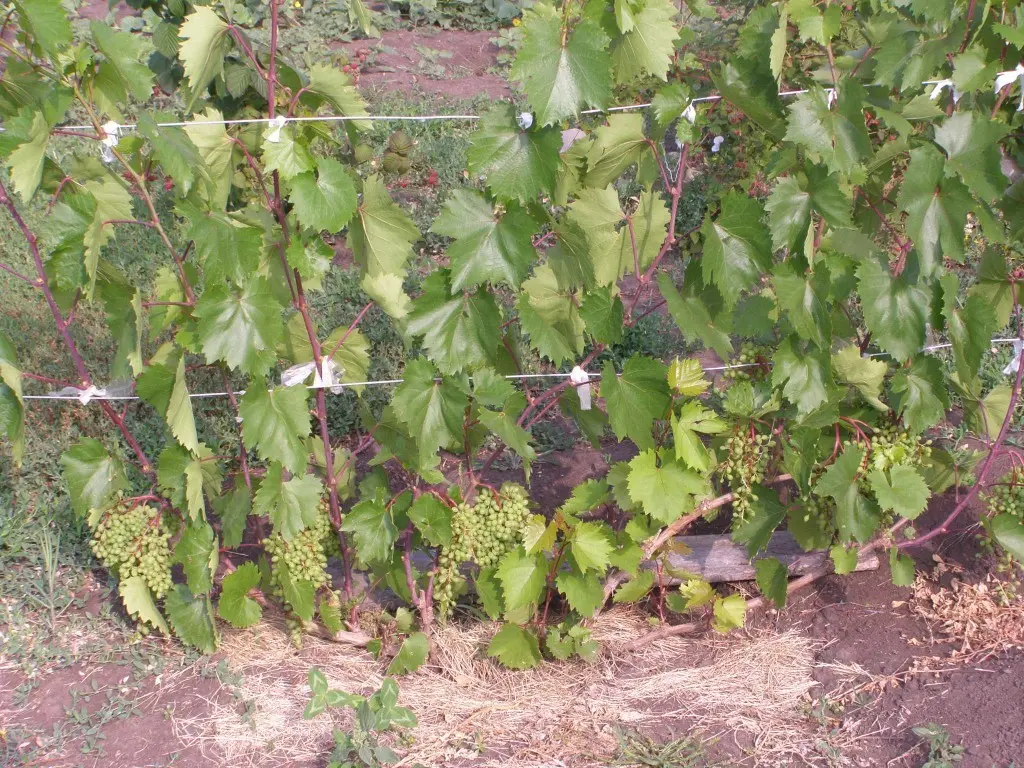
For example, professional gardeners recommend pruning covering species in autumn. This will help to carry out shelter more efficiently and effectively and will well protect the bush from possible frosts. In addition to this, care for a pruned bush in the spring will be easier, and next fall you will get a larger volume of harvest.
In the case when the bushes overwintered normally, a normalizing fragment is carried out during spring growth.
It is not recommended to prune the plant in the spring (sometimes such a mistake can be found among novice gardeners). This is due to the fact that grapes are characterized by slow healing of various injuries. When pruning the vine before or at the very beginning of sap flow, the formation of “tears” on the cut is possible. As a result, there is no need to hope for a good yield of the bush, and this is at best, and at worst, the death of the entire plant is possible.
In spring, only careful pruning is possible, but only when the air temperature is not lower than +5 degrees. Using this method, you can only cut seedlings planted in autumn or young grapes that have not yet entered the fruiting period. If you still have little experience in this matter, then without urgent need it is better to refrain from such pruning.
In the summer, pruning can also be done, but this will not be a complete process. It consists in plucking shoots, pinching, chasing and breaking out branches that are no longer needed.
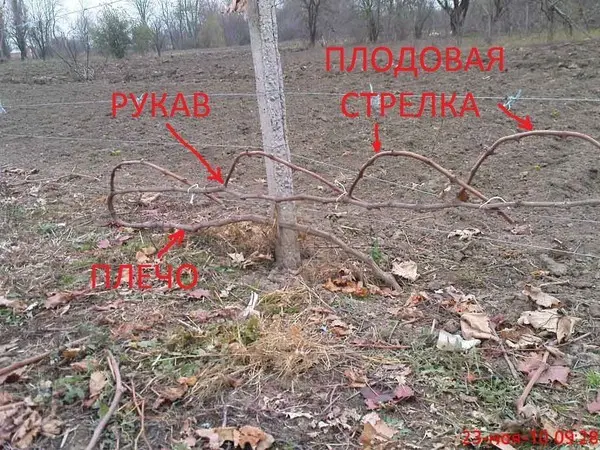
Pruning of non-covering varieties is different in that it can be carried out immediately after the leaves have completely fallen, and not just before covering. In this case, you will achieve the absence of “tears” in the spring. But this option also has disadvantages:
- reducing the resistance of the bush to frost and frost;
- the inability to compensate for potential damage to the kidneys (it can only be compensated for by left eyes).
Knowing all the subtleties of grape pruning of different times for beginners, you can avoid a lot of problems.
Carrying out this or that pruning, you need to clearly navigate the features of each of them, so as not to lead the plant to death.
Why do pruning?
Some amateur gardeners, carrying out the above manipulations, do not even think about their meaning and do everything “just like that”. This applies to beginners who are not fully aware of the full need for this procedure.

Consider all the advantages that grape pruning gives:
- increase in productivity. This applies not only to the volume of the crop, but also to the quality and size of the berries themselves;
- increase in the rate of fruit ripening;
- the care of the bush and harvesting is greatly facilitated;
- the plant takes on a well-groomed appearance (unlike uncircumcised bushes, which eventually begin to grow in all directions);
- the ability to save frost-damaged branches of a grape bush (its trunk). In this case, it is necessary to cut off the aerial part of the bush;
- creation of a new skeleton of a bush in the case when its aerial part died;
- prevention of most diseases (especially summer pruning);
- an increase in the overall ventilation of the bush;
- increase in sunlight for bunches;
- creation of the most favorable conditions for the ripening of the crop;
- elimination of unnecessary, diseased, weakened and broken branches;
- increasing the flow of nutrients to the berries;
- makes it possible to ripen those vines that will be needed next year;
- leaf thinning.
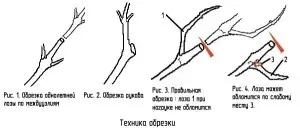
Thus, based on the number of the above advantages of this process, we can say with confidence that it is simply necessary to carry out these manipulations. Moreover, this must be done on time and correctly.
Pruning instructions
Instructions for the method of pruning vines may vary. It all depends on the timing of it.
Algorithm of actions in the spring:
- before starting the procedure, it is necessary to familiarize yourself with the necessary literature or consult with experienced gardeners;
- prepare all the necessary tools: garden saw, pruner, scissors;
- tools should be well washed and sharpened;
- it is necessary to start pruning in March before the eye swells and rapid sap flow;
- you need to remove or simply shorten the old crown and annual shoots;
- you need to inspect the bush and begin the process of thinning – removing all unnecessary and diseased vines and branches;
- when choosing a new fruit shoot, the following characteristics should be taken into account: health, strength and growth rate, diameter (not less than 6 mm);
- the replacement knot should be the branch that grows closest to the trunk;
- pruning occurs by the following method – a thick vine is bent towards itself and the desired branch is removed with sliding movements of the saw or pruner;
- on the bush, after the secondary vegetation, it is possible to remove from 50 to 90% of the growth per year;
- it is necessary to leave, without fail, two healthy and strong shoots;
- these shoots are shortened by five eyes;
- cuts should be even, without the formation of large wounds on the wood;
- the cut must be done only perpendicularly, without bevel;
- it is possible to form the necessary “skeleton” on a young bush;
- circumcision is carried out “on the fruit link”, leaving on each shoulder a small amount of vines with shoots that have sprouted in a year;
- the upper shoot or fruit arrow is cut into six buds;
- one vine should be left to bear fruit;
- then repeat the process the next year.
Following this instruction, you can form a double-sided fan formation of a grape bush.
Remember that during the first growing season you need to get two healthy and strong shoots, and for the second – 4, for the third – 8.
Therefore, in three years you will receive a fully formed grape bush and the first harvest.
After that, it remains only to form the number of inflorescences – leaving one bunch for two shoots, you can get larger berries.
Fall pruning instructions:
- start pruning after the leaves fall or before shelter;
- the branches of the second year are cut into two buds, while the branches of the third and fourth years must be shortened by four buds;
- remove only broken, infected branches. More, in this situation, cutting is not recommended, otherwise you can significantly harm the plant.
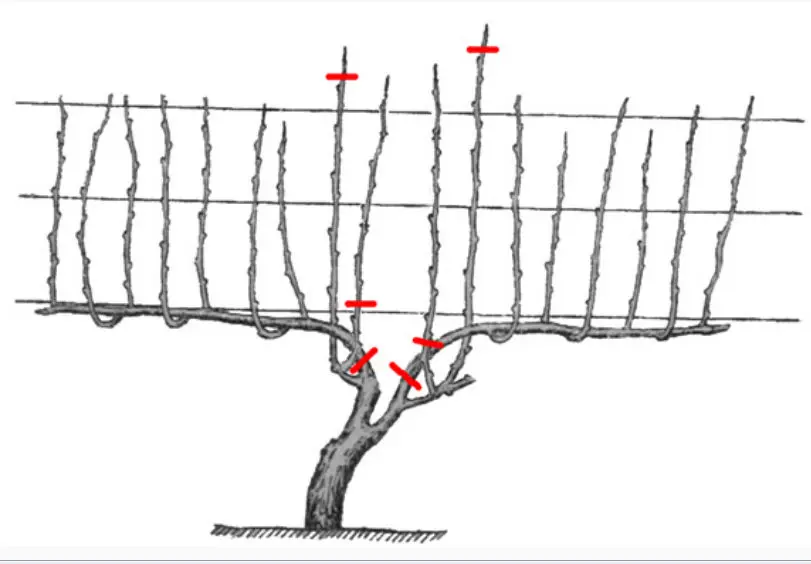
Useful Tips
Experienced growers, over the years of working with the plant, have developed a number of useful tips that will help novice gardeners avoid many problems and failures.
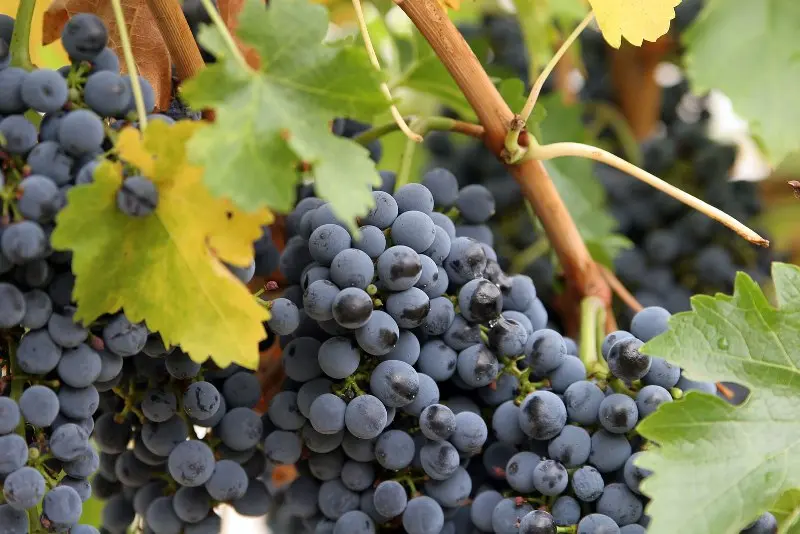
Helpful hints for those new to clipping behavior:
- during this procedure, four buds should be left on the replacement knot, while 11 or 13 buds should be left on the fruit arrow (it is necessary for insurance purposes if the winter is very frosty and the branches are severely frozen);
- damage, wounds and cuts should be on the inside of the shoots, which faces the middle of the bush. This will lead to optimal recovery and movement of the juices;
- cuts should be as smooth as possible;
- the shoots that you leave for fruiting should be undamaged, healthy, perfectly ripened, have a maximum length, have an average thickness and a diameter of about 6-12 mm;
- do not damage perennial shoots;
- after harvesting, you need to accurately determine the shoot that has already borne fruit and cut it off;
- for better orientation during these manipulations, the branches needed for removal can be marked, leaving bunches of berries on them;
- grape branches should not be cut into a ring, as is customary for other crops. Pruning in this situation is carried out with the preservation of a small hemp, since the wounds on the grapes do not tend to overgrow, but only dry out;
- do not save pruning until next year;
- Of all the tools, the secateurs are considered the most convenient and practical to use.
Video “Pruning grapes in autumn”
In this video you can view a visual instruction for the autumn pruning of grapes.
In order for even a beginner in gardening to be able to prune grapes, you must first familiarize yourself with the proper recommendations of experienced gardeners and only then proceed to the direct process. Otherwise, you risk getting a result that is the opposite of what you expected, and the resulting picture of a dead grape bush will not please anyone.









